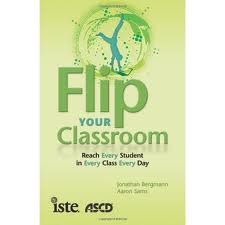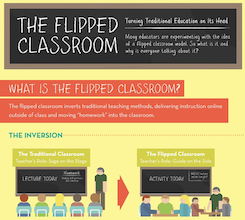Inside the Flipped Classroom
Flip Your Classroom: Reach Every Student in Every Class Every Day
by Jonathan Bergmann and Aaron Sams
(ISTE/ASCD, 2012 – Learn more)
While I’m not sure if you’ll flip over this book, authored by two early proponents of a much-talked-about instructional strategy, you’ll likely appreciate its authenticity. Flip Your Classroom comes straight from the current practice of real classroom teachers.
Here’s brief explanation of “flipping” from the publisher’s publicity materials:
It started with a simple observation: Students need their teachers present to answer questions or to provide help if they get stuck on an assignment; they don’t need their teachers present to listen to a lecture or review content. From there, Jonathan Bergmann and Aaron Sams began the flipped classroom: Students watched recorded lectures for homework and completed their assignments, labs, and tests in class with their teacher available.

Any individual teacher wondering where to start with flipping will also appreciate this book. Chapter 4 is titled “How to Implement the Flipped Classroom,” and it’s one of the best how-to chapters I’ve ever read on an education related topic. It was easy to hear Bergmann and Sams explaining ideas to me as I read, and I had a clear picture of the steps I needed to undertake if I wanted to start flipping in my own middle school classroom. I also think the chapter presented many alternative ways to get to the same ending point — not something you normally find in a how-to chapter.
A teacher-friendly book
I think you’ll like the tone of the writing. It was easy to read and easy to imagine how these teachers began to explore this instructional style and kept working at making improvements. There are tons of tips, including lists of things you should have on hand should you choose to implement. What I like most about the book is that it’s clear these author-teachers are using technology because they believe it will improve their instruction and help students learn more. They didn’t flip their classroom because it was the latest fad or just to use tech for tech’s sake.
It’s inspiring to read how practicing teachers found a way to create more “time” to spend with their students. Bergmann and Sams describe how much better they know their students and their students’ capabilities after adopting the flipped model. Instead of spending the bulk of their school time lecturing or explaining content to the whole class, they now use their classes as student-driven workshops or labs where they monitor, confer and teach tailored mini-lessons to smaller groups of students.
A little too much, too fast
The last section of the book introduces the next iteration of the flipped classroom — something the authors call the Flipped-Mastery Model. WOW. I will readily admit that I was still reeling from all the basic decisions I needed to make just to get started: how it all fits with my teaching philosophy; the pragmatics of making videos (no small undertaking); the impact on lesson planning — all the instructional issues that will surely come to your mind as well.
Just when all this was churning away in my mind, along came Chapters 7 and 8, taking me on a fast walk through the advanced version of flipping before I was quite sure this was an instructional strategy I could accomplish. I understand why the authors didn’t want to chop the topics into two books, but I would have preferred that the last two chapters stick with basics.
Even with these reservations, in the last two chapters Bergmann and Sams continue to provide the reader with a clear, compelling tale of what they did and why and how they did it. So what is the Flipped-Mastery Model? It individualizes and differentiates instruction based on student needs and each student’s pace of learning. “Flipped mastery allows the direct instruction to be asynchronous, so differentiation for each student becomes possible,” they explain. If I were really ready for this level, I think I’d need more than these two chapters to help me achieve Flipped Mastery, but it’s a wonderful bird’s eye view of the possibilities of using this instructional strategy.
Flip Your Classroom: Reach Every Student in Every Class Every Day is a definite keeper for my professional library. It’s one of a number of books I’ve seen lately that may be part of a new style: short, to-the-point, and written expressly to help teachers study new ideas.
____
Marsha Harding Ratzel is a middle school math and science teacher. Marsha lives in Prairie Village, Kansas and has been actively involved investigating how to best utilize technology in the classroom for much of her teaching career. She earned her National Board Certification in science in 2001. She blogs at Reflections of a Techie and contributes to the Voices from the Learning Revolution blog.
Marsha wrote about her own teaching journey in this recent MiddleWeb guest article.

































4 Responses
[…] A MiddleWeb Book Review Flip Your Classroom: Reach Every Student in Every Class Every Day by Jonathan Bergmann and Aaron Sams (ISTE/ASCD, 2012 – Learn more… […]
[…] A MiddleWeb Book Review Flip Your Classroom: Reach Every Student in Every Class Every Day by Jonathan Bergmann and Aaron Sams (ISTE/ASCD, 2012 – Learn more… […]
[…] A MiddleWeb Book Review Flip Your Classroom: Reach Every Student in Every Class Every Day by Jonathan Bergmann and Aaron Sams (ISTE/ASCD, 2012 – Learn more… […]
[…] A MiddleWeb Book Review Flip Your Classroom: Reach Every Student in Every Class Every Day by Jonathan Bergmann and Aaron Sams (ISTE/ASCD, 2012 – Learn more… […]